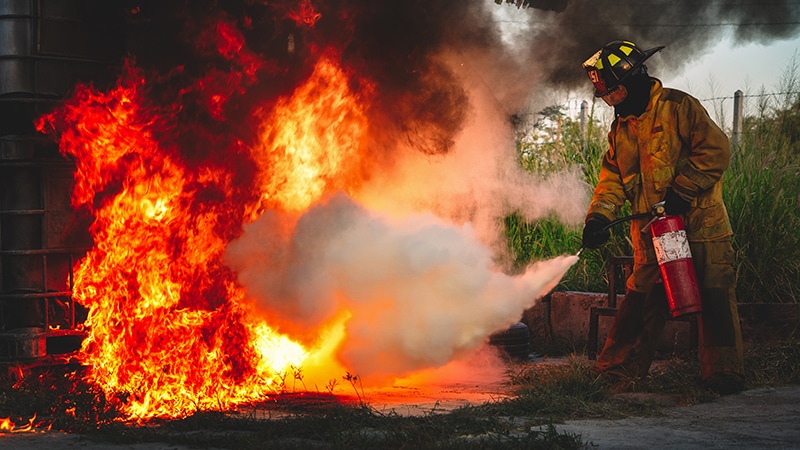The number of fires that firefighters put out yearly is associated with their subsequent risk of atrial fibrillation, a new study suggests.
With increasing fire exposure, defined as fires fought annually, firefighters had a higher rate of atrial fibrillation, reported Paari Dominic, MD, of Louisiana State University in Shreveport, Louisiana, and colleagues.
It is important for firefighters to take any symptoms of weakness, fatigue, dizziness, trouble breathing, and palpitations seriously and seek medical care, because they could be indicators of atrial fibrillation, Dominic told theheart.org | Medscape Cardiology.
“Firefighters need to be advised to schedule routine primary care visits to enable early detection of atrial fibrillation. Finally, although they cannot alter their exposure to fires as a firefighter, they should be advised that they may still be able to reduce their risk of atrial fibrillation by adequately treating/controlling other additive risk factors, like high blood pressure, diabetes, sleep apnea, and obesity,” Dominic concluded.
The findings were published in the Journal of the American Heart Association on March 23.
“This paper showed that a higher number of fires fought per year was associated with an increased risk of atrial fibrillation. It highlights the concern occupational exposure to inhalant chemicals and psychosocial stress may play on the effects of cardiovascular disease risk,” said Rachel Bond, MD, an assistant professor in the Department of Internal Medicine at Creighton University School of Medicine, in an email.
These data may imply that medical providers should be routinely assessing for cardiac arrhythmias and potential underlying causes for such arrhythmias, like sleep apnea through a sleep study, noted Bond, who was not involved in the study.
“As atrial fibrillation can sometimes be asymptomatic but lead to increased risk of a cardioembolic event, such as a cerebrovascular accident, this would be prudent to ensure, at minimum, firefighters are getting annual electrocardiograms,” she added. “Beyond that, it may encourage clinicians to advise their patients to use smartwatches/applications that may detect such underlying arrhythmias.”
Duty-Associated Deaths
Cardiovascular disease has been previously reported at autopsy in a substantial proportion of duty-associated deaths of firefighters, which may be due to job-associated factors and personal risk factors, such as sympathetic nervous system activation linked with responding to crisis, strenuous work, and exposure to harmful products of combustion, the researchers note.
The investigators assessed 10,860 active firefighters. Men comprised 93.5% of the cohort, and 95.5% were 60 years of age or younger.
The researchers collected data electronically from the REDCap database through Louisiana State University Health Shreveport. Members of at least one of five predetermined professional societies were electronically polled by the societies. The questionnaire was used to gather information regarding the number of fires battled annually to determine work-related exposure and self-reported cardiovascular disease.
A considerable increase in the incidence of atrial fibrillation was found among firefighters who fought more fires yearly.
Table. AF Risk by Annual Fire Exposure
| Number of fires per year | Incidence of AF (%) |
|---|---|
| 31 or more | 4.5 |
| 21 – 30 | 3.0 |
| 11 – 20 | 2.7 |
| 6 – 10 | 2.3 |
| 0 – 5 | 2.0 |
The findings from a multivariable assessment also showed that the number of fires battled each year was linked to an increase in incidence of atrial fibrillation (odds ratio, 1.14; 95% CI, 1.04 – 1.25; P = .006).
Dominic noted there was a dose-response relationship at play. “There was approximately a 20% to 50% increase in the atrial fibrillation prevalence in firefighters for every additional 10 fires they fought. Next, we were surprised to find that 2.5% of firefighters less than the age of 60 had atrial fibrillation, as opposed to 0.1 to 1% prevalence of having this disease in non-firefighters, an approximate doubling of risk at the least,” he said.
Notably, the number of fires fought did not appear to be associated with an increase in the risk of stroke, Dominic added.
Limitations of the study include the small group of survey respondents with transient ischemic attack and/or stroke history, a lack of a substantial control group that was not composed of firefighters, and that some participants may have retired owing to atrial fibrillation or sequelae, the study authors note.
Another limitation is that the study was based on self-reported survey data that likely were influenced by reporting bias, they added.
“Further research into causal relationships, underlying mechanisms, and risk mitigation strategies is crucial and will lead to a better understanding of cardiovascular risk factors in firefighters and the ability to protect and care for firefighters in the line of duty,” the researchers conclude.
Dominic reports no relevant financial relationships.
J Am Heart Assoc. Published online March 23. Full text
Ashley Lyles is an award-winning medical journalist. She is a graduate of New York University’s Science, Health, and Environmental Reporting Program. Previously, she studied professional writing at Michigan State University, where she also took premedical classes. Her work has taken her to Honduras, Cambodia, France, and Ghana and has appeared in outlets such as The New York Times Daily 360, PBS NewsHour, The Huffington Post, Undark, The Root, Psychology Today, Insider, and Tonic (Health by Vice), among other publications.
For more news, follow Medscape on Facebook, Twitter, Instagram, and YouTube.
